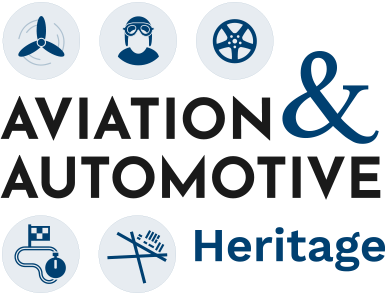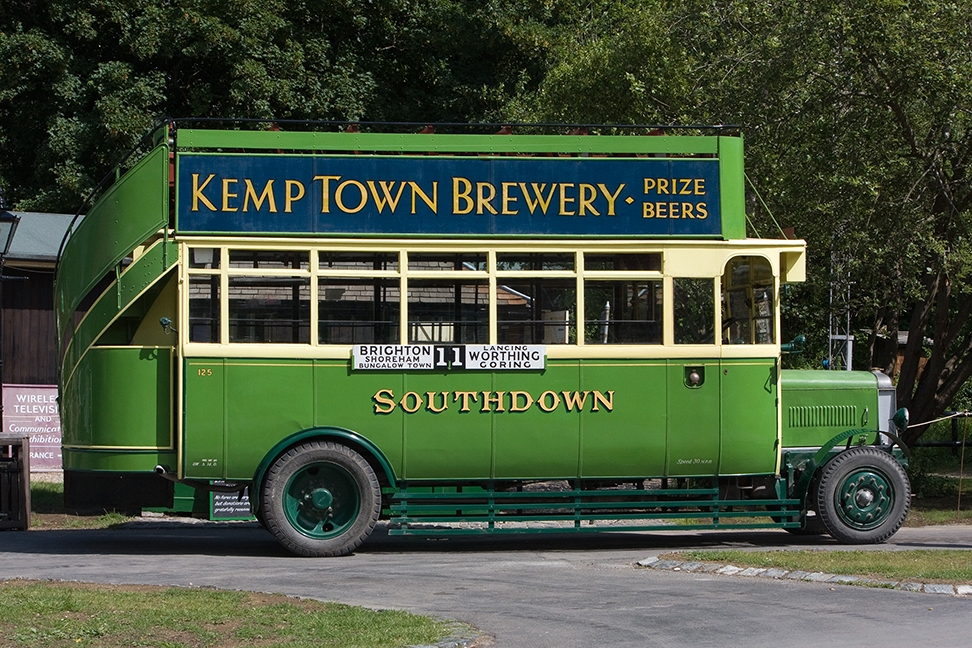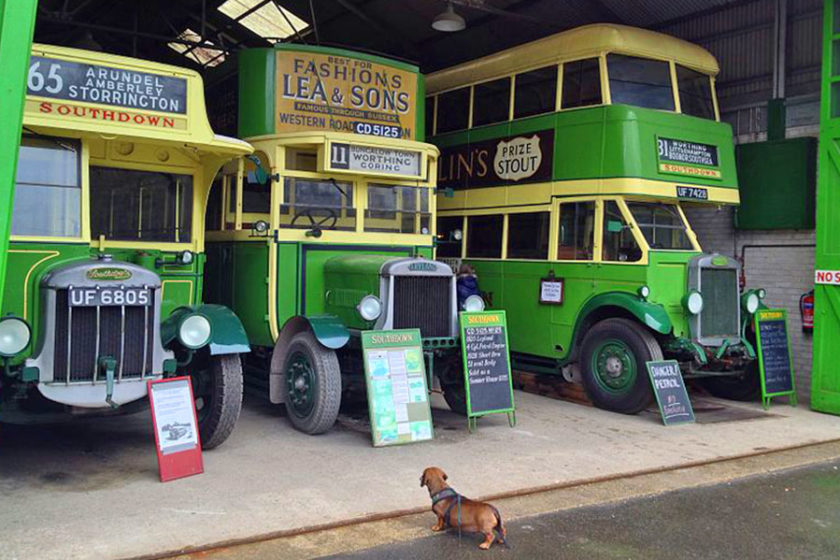The First World War was directly responsible for the formation of Southdown Motor Services Ltd. As a result of fuel supplies being cut, staff being signed up for military service and their best vehicles being commandeered by the War Department, three competing companies based in Worthing and Brighton were forced, in 1915, to merge in order to survive. So with a fleet of 38 vehicles of many different designs and just six routes, the company set about carrying the increased traffic which was mainly generated by troops from camps around Seaford.
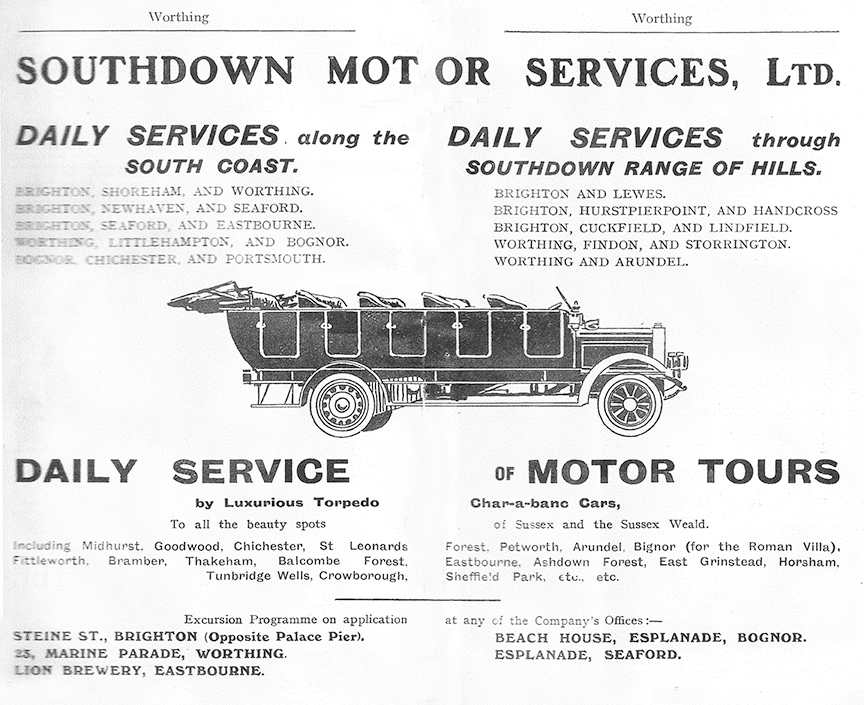
Southdown advert c.1915
With peace, came further traffic growth, partly due to the expansion of residential areas such as Rottingdean, Saltdean and Seaford and partly due to the ever-increasing holiday trade on the South Coast. Consolidation came with the acquisition of no fewer than 69 other operators between 1920 and 1939. This brought the company not only bus routes, but express coach services, mainly to London, such as with the acquisition of Southern Glideway of Eastbourne; private hire work; excursions and extended tours, both domestic and continental, particularly with the acquisition of Chapman & Sons of Eastbourne in 1932.
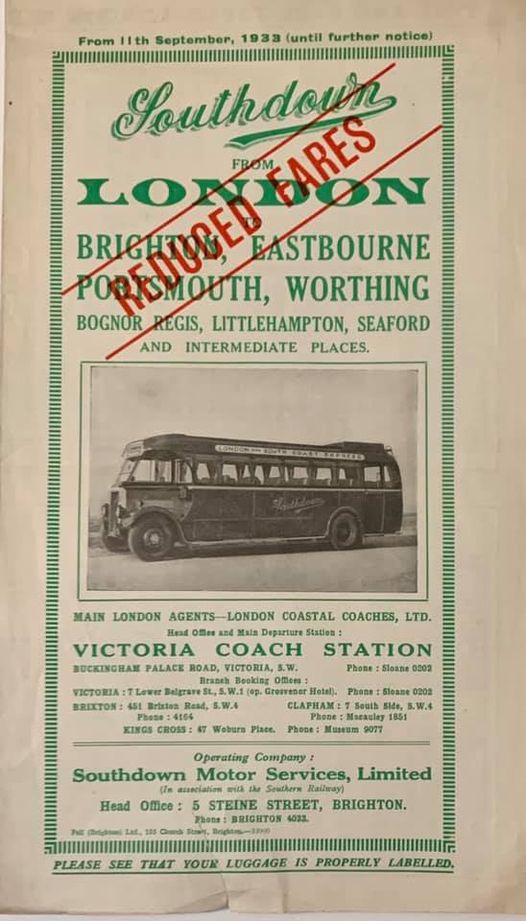
1933 London Express leaflet
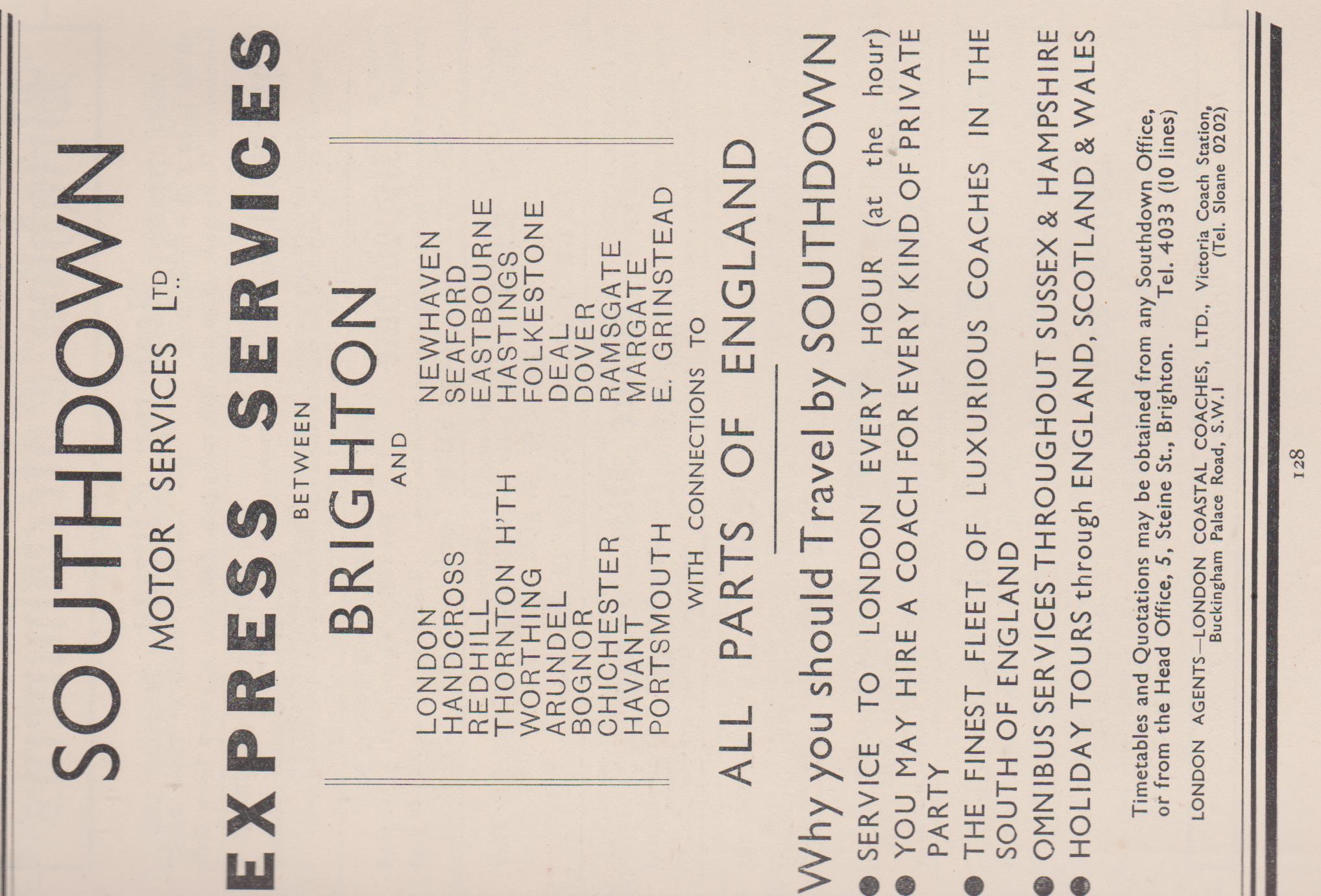
Southdown Motor Services, Ltd advert c.1934
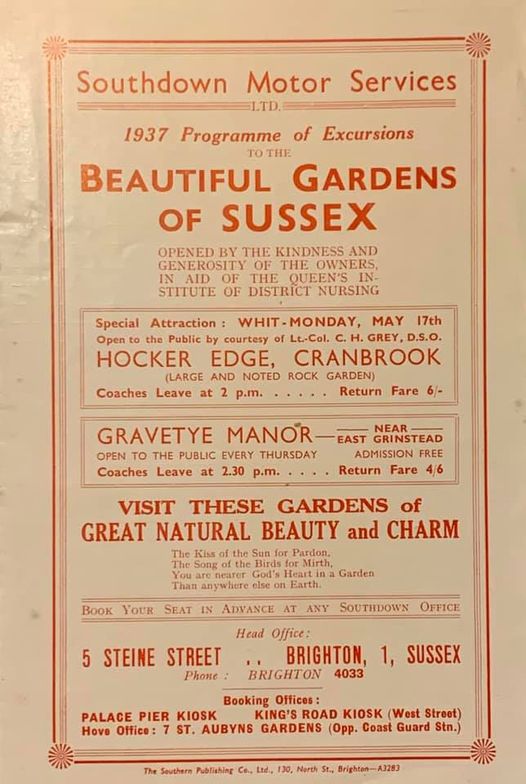
1937 Beautiful Gardens of Sussex programme of excursions
The fleet had now grown to 726 modern vehicles, which in their reliability and comfort, bore little resemblance to the original. Garages were built to house them in most towns and many villages and one of the earliest central overhaul works in the country was opened at Portslade in 1928. Locally, Heathfield garage opened in 1927, with Uckfield bus station and garage opening in 1936. A feature of operations in East Sussex was the development of joint services with Maidstone & District Motor Services Ltd to Tunbridge Wells, Hawkhurst and Hastings.
The Second World War brought another story of shortages and hardships which left behind a trail of broken vehicles and damaged buildings. The release, however, by the Government of a number of new double-deckers, albeit to ‘utility’ specifications, was crucial.
With peace again, and helped by these very reliable ‘utilities’, as well as its hard-working staff, many ex-military , “Southdown” became a household name along the whole coast from Eastbourne to Portsmouth and for many miles inland. In fact, the area of operation covered some 3,000 square miles served, in 1950, by 132 routes. The smart green and cream buses and coaches, which blended so well with the countryside they served and which added a welcome degree of colour to the towns, were recognised both locally and further afield.
The Fifties were to be the heyday of Southdown with the fleet peaking at 1,025 vehicles in 1955. The joint operations with the Maidstone Company had been enhanced in 1948 with a through service from Brighton to Gravesend, at 62miles, the longest bus route in the land. Then, in 1957, the equally famous ‘Heathfield Pool’ was launched whereby three connecting routes at Heathfield became six through routes using 12 Southdown and eight Maidstone buses and with these buses, but not the drivers, being away from their home base for up to a week at a time!

A 1954 Southdown coach cruise brochure
One of the last acquisitions was that of well-respected Beacon Motor Services of Crowborough in 1949, while bus stations were opened at Lewes in 1954 and at Haywards Heath in 1956.
However, difficult times were never far away. Several summers with poor weather, a shortage of fuel during the Suez Crisis, increasing pressures from Government fuel duty and wage demands for the staff through their Trade Unions combined with a more affluent society that could afford to buy cars and televisions, so no longer relying completely on the bus for work, for leisure or the cinema.
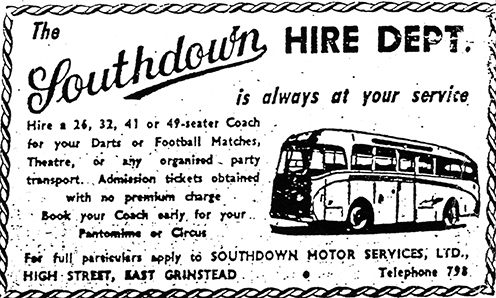
East Grinstead Southdown coach hire advert c.1960
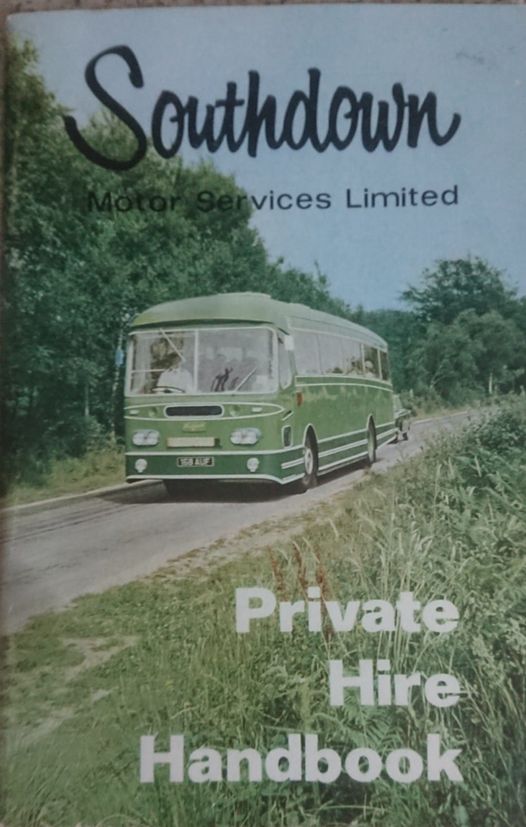
1965 Private Hire Handbook
The Sixties saw the advent of cheap package holidays abroad, which inevitably led to a decline in traditional holidays and so coaching activity. With the extra traffic on the roads, congestion followed, so bus services became increasingly unreliable to operate. The financial cost, too, of congestion, combined with that of fuel, maintenance, new vehicles and wages led to drastic measures. One-man operation that had only applied to the most rural routes was dramatically extended, but without a conductor, further unreliability and loss of service was likely.
Ironically, it was at this time that a lavish new head office – Southdown House – was finally built in Freshfield Road, Brighton to replace cramped facilities in Steine Street that had served the Company so well for 50 years. A case of too much too late!
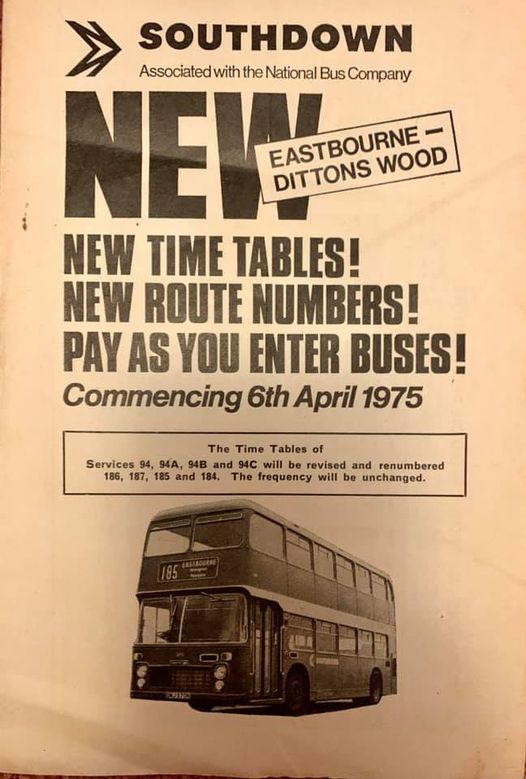
A 1975 Southdown timetable
1970 was momentous for Southdown and the UK bus industry with full nationalisation under the auspices of The National Bus Company. At this time, Brighton, Hove & District was absorbed. Although Southdown had some success in retaining its identity for a while, it soon succumbed to the regulation drab green livery for buses and allover white for coaches, to devastating cuts, particularly to the rural network, and to complete one-man operation.
With a change of Government, politicians intervened again, in 1986, with privatisation and deregulation. At this time, councils, such as East Sussex County Council, took on full responsibility for tendering the many uneconomical rural routes that hitherto may have been cross-subsidised from commercial services. This soon led to small independent operators starting up to take advantage of these contracts. To prepare for the new era Southdown had been split into four divisions – East & Mid Sussex, Brighton & Hove, West Sussex and Hampshire with Southdown Coaching another unit. These divisions were soon subject to management buy-outs, which ultimately, and probably inevitably, led to onward sale to large groups that were developing.
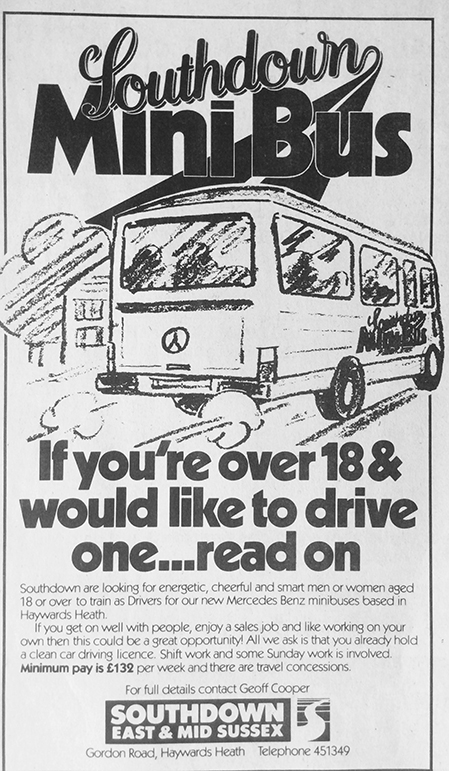
Haywards Heath mini bus flyer c.1985
In 1989, all areas outside Brighton & Hove were taken over by the Scottish company, Stagecoach, with its distinctive trademark red, tan and blue livery. Service levels were generally maintained, but the Southdown name, which by now had become a by-word for unreliability, was largely superseded by different marketing names and operation was often controlled from offices well outside the area, with all of the consequences that can bring! Later on, the Southdown name was revived, but only as a technicality in the legal lettering carried by all buses. Sadly, in 2014 it was announced that even this was to be ended. However, largely through the existence of individuals with their lovingly preserved vehicles, rallies, running days and groups such as The Southdown Enthusiast’s Club, Southdown will be remembered for many years to come.
You can visit the collection of restored buses at the Southdown Bus Garage at Amberley Museum near Arundel. Click here for more information.
Amberley Museum
Website: www.amberleymuseum.co.uk
